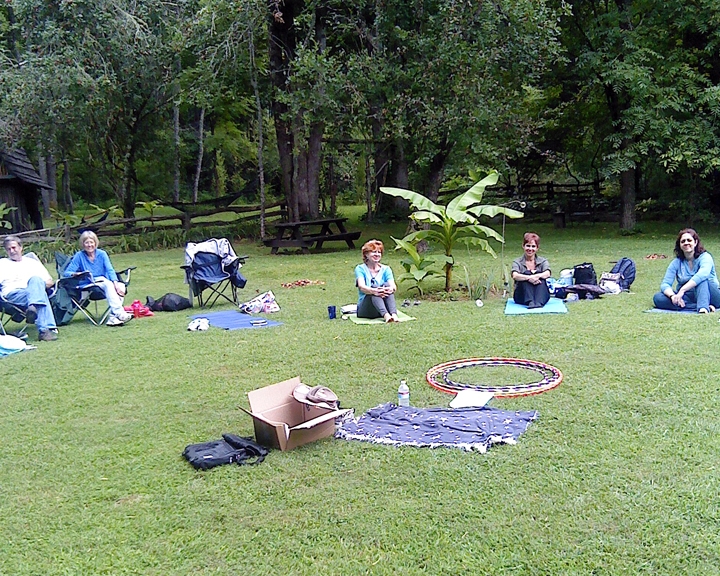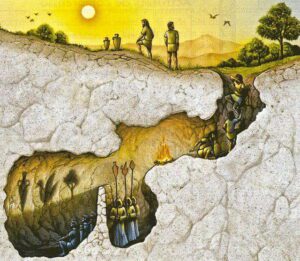With his tail ablaze from the sacred fire, Coyote ran for many miles. As he ran, feeling the pain from his burning tail, he thought about all of the things he had experienced on the journey so far. He especially thought of Coyote Woman. She seemed so different at the fire circle than she had when he had met her on the trail.
How could this be?
While he ran, the answer came to him. Like himself, Coyote Woman was a Trickster. What if, when he met her on the trail, she was playing a prank of her own? What if, when she had abandoned him on the trail, she had done so in order to goad him into completing his journey?
As he pondered this he began to smile. The Trickster had been tricked again. He had been given another dose of his own medicine. But Coyote Woman had played her tricks to teach him and to lead him to complete the quest.
With this thought, he stopped running. Exhausted, he flopped down in the snow, breathing heavily. He had come to rest on the side of a mountain with a clear view of the valley below him. The fire from the sacred circle still burned brightly at the tip of his tail, but the pain was now diminishing to a warm glow. It was uncomfortable, but it was not unbearable.
As he rested, Coyote thought about how each creature in his Tribe lived according to his nature. Brother Eagle was a stern hunter and visionary who saw far, so he lived a serious life. Brother Bear was strong and knew the herbs, so he lived a life of ease and healing. Sister Cougar was crafty and wise, and lived the solitary life of the hunter. Sister Salmon was quick and sleek, and lived a busy life jumping from stream to stream.
But Coyote was playful and mischievous, so he spent his days running to and fro about the earth playing tricks on all the other People.
He rested his chin upon his paws as he thought of how he had managed to steal the fire. He had tried all of his usual tricks, but Coyote Woman had seen right through them. Yet when he embraced his own nature as a Trickster, and trusted his own instincts, he was able to find a solution, even though painful. When he closed his eyes and leaped backward into the fire, he had become who he was born to be.
Coyote mulled over his choices. He really should be going soon. He wasn’t sure how long the fire on his tail would continue to burn, and he still had a long way to go to bring the fire back to his own tribe.
On the other hand, it felt good just to lie here in the snow. Although the icy ground was cold, the warmth from the fire on his tail was keeping him cozy, helping him to find balance between the fire and the ice.
As Coyote began to regain his breath, he pondered what he saw at Coyote Woman’s Village of the Sacred Fire. All of the animals there were warm and happy despite the chill of winter. They all danced before the flame in their joy. They truly seemed to live a life of ease.
It
was so tempting to return to that place. While the return home was long and
arduous, Coyote could, if he chose, simply return to Coyote Woman’s village and
join them forever. There would be no need to face the perils of the road back
to his own village. He had found what he was looking for. He had captured the
sacred flame. If he didn’t return then the People of his own village might
freeze to death, but was that really his concern? How would it benefit him
personally to bring the fire back to his People, when he could instead just
return to Coyote Woman’s village, give them their fire back, and beg
forgiveness? Perhaps they might even take him into their tribe as a member!
Phase Three: Return
In the Return Phase, the hero has gained wisdom about the nature of reality and consciousness, and is now faced with the challenge of returning to the world to teach those who are willing to listen. It is the process of coming home with the Holy Grail. It is the act of bringing the Ten Commandments down off the mountaintop. It is the skill of helping others to achieve what the hero has achieved, while avoiding the temptation to turn them into carbon copies of himself. For a spiritual seeker, this means applying lessons learned in the spiritual realm to daily life. It means learning to see the bigger picture and to trust the vision.
12.0 Refusal of the Return – Nature as Metaphor
We have now come to the third major phase of the Way of the Coyote: The Return. In Phase One, the Departure, we left the familiar to forge a new trail through unknown territory. In Phase Two, the Initiation, we learned to die to the old way of being so that we could live in a new way, with spiritual eyes and spiritual body. Now, in Phase Three, we learn what it means to return from the Otherworld with the knowledge we have gained. But first we must overcome the Refusal of the Return.
When you have tasted the milk and honey of Paradise, why would you want to leave? Once you’ve journeyed to that place at the center of your being where your True Self dwells, it can be intoxicating. When you’ve experienced the knowledge of your own perfection, it can be difficult to summon the energy to return to an imperfect world. When you’ve experienced the bliss of living fully according to your own true nature as the person you were meant to be, it’s tempting to think that the journey is over. It can be an enticing thought to wish to stay in the Village of the Sacred Fire, to retreat from the world and to live alone.

We might also be tempted to forget that many others have helped us to this place. What if they had chosen to remain in their own versions of paradise instead of teaching others how to achieve what they have accomplished themselves? Would we have ever found the trail without the guidance of those who had been here before?
It has been said that we don’t truly know a subject until we begin to teach it to others. The best way to truly experience living in True Self is to teach others how to do the same. By teaching others we are able to give back to the world while gaining an even deeper understanding of the path.
On the other hand, there is the difficulty of trying to communicate our wisdom to others who have not had the same experience. We will lack a common frame of reference because we have not walked the same path. Once our perceptions have been transformed along the journey to True Self and we learn to see things in new ways and speak a new language of the spirit, it can feel like it’s impossible to communicate with those who haven’t learned the same language.

In Plato’s Cave Allegory, the Seeker learns to see beyond the illusions we live by and into the real nature of things. In the Cave, these illusions take the form of shadows projected on a wall. The shadows are of people and animals. The shadows are not the people or animals; they are merely an illusion and a projection of the real people behind the shadows. In Plato’s Cave, the Seeker sees the real people and animals behind the shadows for the first time. But when he tries to explain the concept of real creatures to the others in the cave, who can see only the shadows, they cannot understand what he means. They lack a common frame of reference.
A return to the “real” world of shadows after living for a time in the world of true substance can be a frustrating experience, especially if you hope to share your newfound wisdom with others. Because of this, it is easy to refuse the return, especially if you have attained your own personal paradise along your journey.
But if we never return, we can never share the wisdom we’ve gained. We can never reach the deeper understanding of the path that comes from teaching it to others. We can become trapped in Xanadu, never to return, and never to help others achieve the same bliss.
How do we resist the temptation to refuse the return? One way to do so is through the use of Nature as Metaphor.
12.1 Nature as Metaphor
Fairy tales were used in the past, and are sometimes still used today, as teaching tools (for a great example of a fairy tale being used as a teaching tool in the modern world, see Robert Bly’s book, Iron John). These stories often contained moral lessons. Another thing most fairy tales contain is archetypal images and elements of nature. Think of your favorite fairy tale. What are the elements of nature in it? Does the fact that it is your favorite fairy tale have anything to do with those elements of nature? Are those elements good like the Goose that Laid the Golden Egg, or bad, like the Big Bad Wolf, or neutral like the beanstalk in Jack and the Beanstalk? What does your fondness for those particular elements of your fairy tale tell you about yourself?
Are there any archetypal elements to your story?
Each of us lives in our own personal fairy tale called “my life.” We all have good things that happen to us, and we all have bad things that happen to us. We create our own personal myths by choosing which things to focus on in our own lives. The good news about the myth of our lives is that we are the authors. So if we don’t like the way the story is going, we have the power to do a rewrite at any time. We can’t always choose the circumstances of our lives, but we can always choose the story we create about those circumstances.
If you go out into the woods and start observing things, you will notice something begin to happen. You will begin to create stories about the events you observe there in the forest.
I remember once when I watched a flock of crows defending their turf against a hawk. I had created personalities for each of the crows, and for the hawk. Before I knew it, I had created back story for each of the characters, and dialogue for the major players. I had watched this show for about ten minutes before I realized that the story I had created in my mind told me a lot more about what was going on inside my own head than what was happening with the birds.
The next time you are able to observe nature for a time, pay attention to what sort of stories come to mind. What could it be that your unconscious mind is trying to tell you? Can you see nature as a metaphor for your own inner journey? To practice the art of observing nature as a metaphor for your own life, download the worksheet and complete the exercise, A Closer Look.

